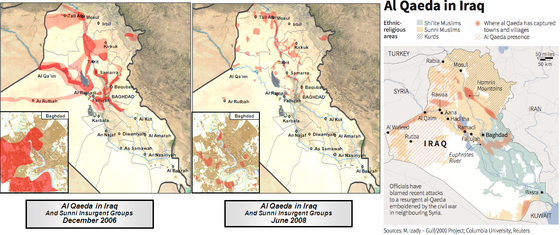Al Qaeda's Islamic State of Iraq and the Sham killed 18 Iraqi Army officers, including a senior general and members of his staff, in a complex suicide attack today in the western province of Anbar.
The commander of the Iraqi Army's 7th Division and the commander of the 28th Brigade were among the 18 officers who were killed after three suicide bombers attacked them in a home in the remote western town of Rutbah, Reuters reported. Several "high-ranking officers" who were members of the division and the brigade staffs were also killed.
The officers were reportedly visiting an area in Rutbah that was subject to a recent military operation targeting al Qaeda.
Rutbah is a smuggler's town and a transit point to Syria, Jordan, and Saudi Arabia in the desert in the southwestern corner of Iraq. Al Qaeda attempted to control the town from 2005 to 2007 in order to facilitate the transit of weapons, cash, and foreign terrorists into Iraq's central regions. With the civil war in Syria and the renewed terrorist insurgency in Iraq, the Islamic State of Iraq and the Sham is attempting to regain control of Rutbah and other border areas in western Iraq, as well as areas it lost late last decade.
Al Qaeda regaining control of areas it lost during the surge
The ISIS has had success in regaining control of areas of Iraq that it lost during combined US and Iraqi counterinsurgency operations from 2007 to 2009. A map recently produced by Reuters shows that the ISIS controls villages and towns along the Euphrates River and the border with Syria as well as in the desert in Anbar, in areas south of Baghdad, in the Hamrin Mountains in Diyala and Salahaddin, and in numerous areas in Ninewa [map is above].
When the Reuters map is compared with maps produced in 2008 by Multinational Forces - Iraq that show al Qaeda control in Iraq in 2006 [leftmost map] at the height of the organization's strength in the country, and 2008 [center map] after the group was driven from many of its sanctuaries, al Qaeda's resurgence becomes clear.
The ISIS began retaking control of areas in Iraq after the US withdrew military, intelligence, and logistical support from the Iraqi military and intelligence services in December 2011. The Syrian civil war has also fueled the resurgence of al Qaeda in Iraq.
ISIS suicide operations continue unabated
The ISIS has not had difficulty in recruiting and deploying suicide bombers in either Iraq or in Syria, where it is a dominant force in the insurgency against President's Bashir al Assad's embattled regime. In Iraq, ISIS has conducted 13 suicide attacks and assaults so far this month and 12 last month, according to a count by LWJ. The US government reported that the ISIS carried out 38 suicide attacks in October. In Syria, the ISIS and the Al Nusrah Front, al Qaeda's other branch, have executed six suicide attacks and assaults so far this month, 11 in November, and nine more in October, according to a count by LWJ.
Of the 13 suicide attacks in Iraq this month, eight have been suicide assaults, or attacks that include more than one bomber and are often accompanied by an armed team of fighters.
The ISIS has conducted numerous coordinated assaults on Iraqi security forces over the past year. The most prominent raid took place on July 21, when assault teams attacked prisons in Abu Ghraib and Taji. At least 26 policemen and prison guards were killed, while hundreds of prisoners, including many senior al Qaeda leaders, escaped. Many are still on the loose.
The ISIS continues to display its capacity to plan and execute coordinated operations against Iraq's security facilities. These attacks are part of multiple 'waves' of al Qaeda's "Destroying the Walls" campaign, which was announced by emir Abu Bakr al Baghdadi, who is also known as Abu Du'a, on July 21, 2012.
